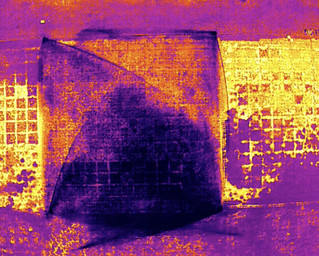Feb. 3, 2023
Arkansas turfgrass research shows drones adaptable to golf course water, labor issues
By John Lovett
University of Arkansas System Division of Agriculture
Arkansas Agricultural Experiment Station
Fast facts
- Water conservation and labor considered major issues in golf course management
- Unmanned aerial system tech used in research also can be used on golf course
- Thermal and multispectral images from drones tell where water is not needed
(657 words)
FAYETTEVILLE, Ark. — Unmanned aircraft systems, also known as drones, used by turfgrass scientists at the Arkansas Agricultural Experiment Station offer potential solutions for two of the biggest challenges in turfgrass management.
Daniel O’Brien, a Ph.D. horticulture student with the experiment station, thinks that water and labor are the two existential issues for the future of golf courses and turfgrass more broadly.
“There is a lot of great turfgrass research being done, but if we don’t get water and labor right, I’m not sure how much we will get to appreciate all of that other great work,” O’Brien said. “When it comes to water and labor issues, particularly on golf courses, drones have tremendous potential to help with both.”
The same thermal and multispectral drone images that researchers use for collecting data on drought studies and wetting agent trials at the Milo J. Shult Agricultural Research and Extension Center in Fayetteville can be practically applied to help turfgrass managers such as golf course superintendents conserve water on their golf courses.
“I can use a drone and see where the grass is hot, or dry, or weak, and can apply a wetting agent there, but I could also see where things are just fine and we don’t need to run any irrigation,” O’Brien said. “This can be a big water-saving mechanism with the information that we’re getting from the sky.”
Turfgrass researchers at the experiment station, the research arm of the University of Arkansas System Division of Agriculture, have used drones to supplement their data collection in wetting agent studies since 2017. Turfgrass wetting agents are soil surfactants that decrease the surface tension of water to help hydrate and penetrate hydrophobic, or water repellent, soils. Hydrophobicity is a prevalent issue on sand-based putting greens, O’Brien said. In addition to managing water directly, wetting agents have also been shown to improve the efficacy of fungicides and pre-emergent herbicides.
As with so many industries, labor shortages are also a serious issue for golf courses, O’Brien said. Whether it is not having enough people to scout the course for potential issues or having only one person available to irrigate stressed areas throughout the day by hand, the lack of personnel presents sizable management challenges for superintendents, O’Brien added.
As a scouting tool, drones offer an opportunity to survey a lot of land in a short amount of time and help a golf course superintendent make informed decisions about where to direct the labor he does have. As a water management tool, the thermal and multispectral cameras on drones go beyond what the human eye can see to help efficiently apply water to the places which need it most, before stress causes serious turf injury.
“Essentially, what we’re asking is, ‘what does a problem look like before it’s a problem?’” O’Brien said.
The Arkansas Agricultural Experiment Station takes part in the National Turfgrass Evaluation Program to test turfgrass species for many different traits, including drought tolerance. In addition to NTEP research, the station also has a longstanding relationship conducting field trials with the Turfgrass Water Conservation Alliance.
“Water issues are super important across the country, especially west of Arkansas where you get into water-limiting environments,” said Mike Richardson, professor of horticulture with the experiment station. “We do trials for the evaluation program that are very focused on grasses that can perform and survive extensive periods with limited to no water.”
Drone-derived thermal images of putting greens have also become an eye-catching way for Richardson to communicate his research.
O’Brien says one consideration that must be factored in with drones is that the technology advances so rapidly that even popular models are not immune from replacement by newer alternatives.
Regardless of the reasons for flying, or what the images are ultimately used for, flying a drone for commercial purposes requires that an FAA-licensed pilot in command present and supervising each flight, O’Brien noted. He also recommended buying an extended warranty with the purchase of a drone.
To learn more about Division of Agriculture research, visit the Arkansas Agricultural Experiment Station website: https://aaes.uada.edu. Follow on Twitter at @ArkAgResearch. To learn more about the Division of Agriculture, visit https://uada.edu/. Follow us on Twitter at @AgInArk. To learn about extension programs in Arkansas, contact your local Cooperative Extension Service agent or visit www.uaex.uada.edu.
About the Division of Agriculture
The University of Arkansas System Division of Agriculture’s mission is to strengthen agriculture, communities, and families by connecting trusted research to the adoption of best practices. Through the Agricultural Experiment Station and the Cooperative Extension Service, the Division of Agriculture conducts research and extension work within the nation’s historic land grant education system.
The Division of Agriculture is one of 20 entities within the University of Arkansas System. It has offices in all 75 counties in Arkansas and faculty on five system campuses.
Pursuant to 7 CFR § 15.3, the University of Arkansas System Division of Agriculture offers all its Extension and Research programs and services (including employment) without regard to race, color, sex, national origin, religion, age, disability, marital or veteran status, genetic information, sexual preference, pregnancy or any other legally protected status, and is an equal opportunity institution.
# # #
Media Contact: John Lovett
U of A System Division of Agriculture
Arkansas Agricultural Experiment Station
(479) 763-5929
jlovett@uada.edu
